ADATA XPG V1.0 Low Voltage Review: 2x8 GB at DDR3L-1600 9-11-9 1.35 V
by Ian Cutress on December 6, 2013 2:00 PM ESTCPU Real World
As mentioned previously, real world testing is where users should feel the benefits of spending more on memory. A synthetic test exacerbates a specific type of loading to get peak results in terms of memory read/write and latency timings, most of which are not indicative of the pseudo random nature of real-world workloads (opening email, applying logic). There are several situations which might fall under the typical scrutiny of a real world loading, such as video conversion/video editing. It is at this point we consider if the CPU caches are too small and the system is relying on frequent memory accesses because the CPU cannot be fed with enough data. It is these circumstances where memory speed is important, and it is all down to how the video converter is programmed rather than just a carte blanche on all video converters benefitting from memory. As we will see in the IGP Compute section of this review, anything that can leverage the IGP cores can be a ripe candidate for increased memory speed.
Our tests in the CPU Real World section come from our motherboard reviews in order to emulate potential scenarios that a user may encounter.
USB 3.0 Copy Test with MaxCPU
We transfer a set size of files from the 120GB OCZ Vertex3 connected via SATA 6 Gbps on the motherboard to the 240 GB OCZ Vertex3 SSD with a SATA 6 Gbps to USB 3.0 converter via USB 3.0 using DiskBench, which monitors the time taken to transfer. The files transferred are a 9.2 GB set of 7539 files across 1011 folders – 95% of these files are small typical website files, and the rest (90% of the size) are precompiled installers. In an update to pre-Z87 testing, we also run MaxCPU to load up one of the threads during the test which improves general performance up to 15% by causing all the internal pathways to run at full speed.
Results are represented as seconds taken to complete the copy test, where lower is better.

The Copy Test shows little difference - only 0.5 seconds between 2400 C11 and 1600 C9.
WinRAR 4.2
With 64-bit WinRAR, we compress the set of files used in the USB speed tests. WinRAR x64 3.93 attempts to use multithreading when possible, and provides as a good test for when a system has variable threaded load. WinRAR 4.2 does this a lot better! If a system has multiple speeds to invoke at different loading, the switching between those speeds will determine how well the system will do.
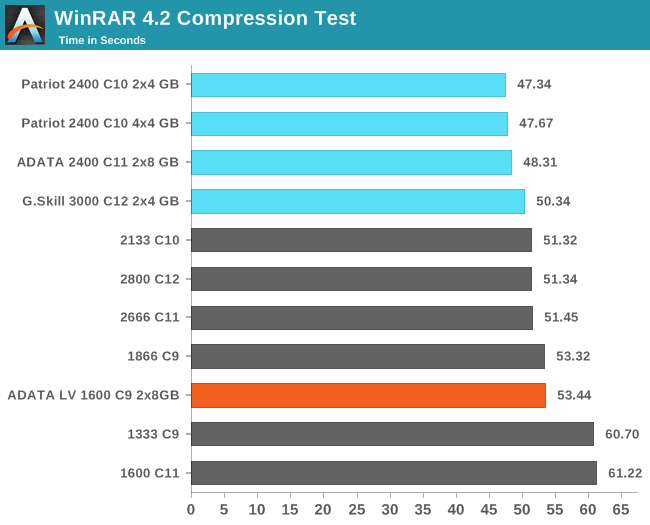
WinRAR is usually the benchmark that shows the biggest difference between the memory kits, and the ADATA LV is some 6 seconds off the pace. The hole of 1333 C9/1600 C11 is avoided.
FastStone Image Viewer 4.2
FastStone Image Viewer is a free piece of software I have been using for quite a few years now. It allows quick viewing of flat images, as well as resizing, changing color depth, adding simple text or simple filters. It also has a bulk image conversion tool, which we use here. The software currently operates only in single-thread mode, which should change in later versions of the software. For this test, we convert a series of 170 files, of various resolutions, dimensions and types (of a total size of 163MB), all to the .gif format of 640x480 dimensions. Results shown are in seconds, lower is better.

FastStone shows memory indifference.
Xilisoft Video Converter 7
With XVC, users can convert any type of normal video to any compatible format for smartphones, tablets and other devices. By default, it uses all available threads on the system, and in the presence of appropriate graphics cards, can utilize CUDA for NVIDIA GPUs as well as AMD WinAPP for AMD GPUs. For this test, we use a set of 33 HD videos, each lasting 30 seconds, and convert them from 1080p to an iPod H.264 video format using just the CPU. The time taken to convert these videos gives us our result in seconds, where lower is better.
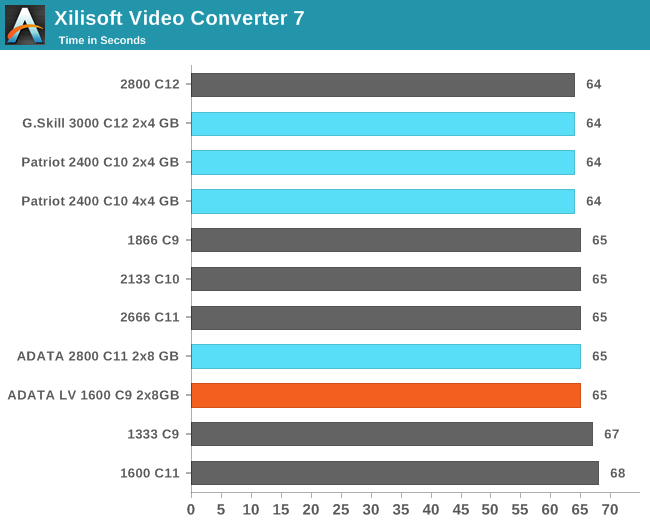
XVC shows WinRAR like differentiation on a smaller scale, with <5% coverall all memory speeds. That might matter for large conversion projects.
Video Conversion - x264 HD Benchmark
The x264 HD Benchmark uses a common HD encoding tool to process an HD MPEG2 source at 1280x720 at 3963 Kbps. This test represents a standardized result which can be compared across other reviews, and is dependent on both CPU power and memory speed. The benchmark performs a 2-pass encode, and the results shown are the average frame rate of each pass performed four times. Higher is better this time around.
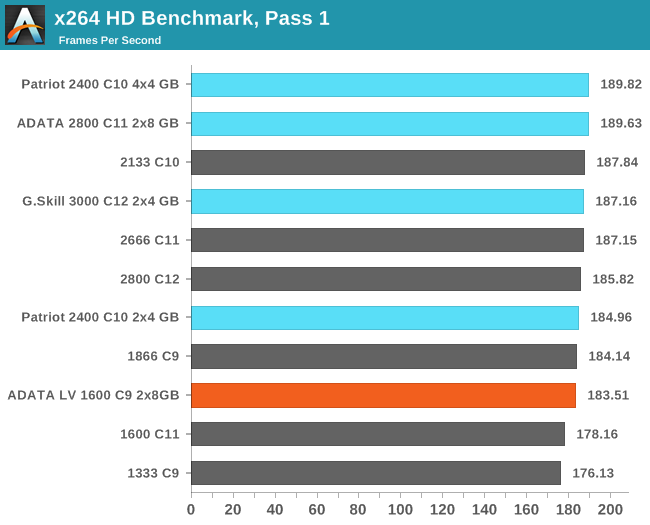
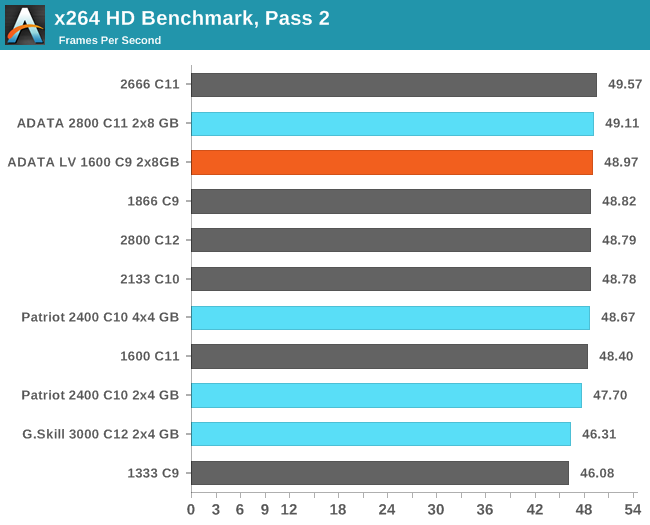
Same story with x264 as with XVC, except we see a reversal of fortunes with pass 2. As pass 2 is optimised after pass 1, it all depends if a second pass is needed. In the comments of some reviews, it seems some of our readers only perform the single initial pass, where the high end memory is ~3% faster than the ADATA LV.
TrueCrypt v7.1a AES
One of Anand’s common CPU benchmarks is TrueCrypt, a tool designed to encrypt data on a hard-drive using a variety of algorithms. We take the program and run the benchmark mode using the fastest AES encryption protocol over a 1GB slice, calculating the speed in GB/s. Higher is better.
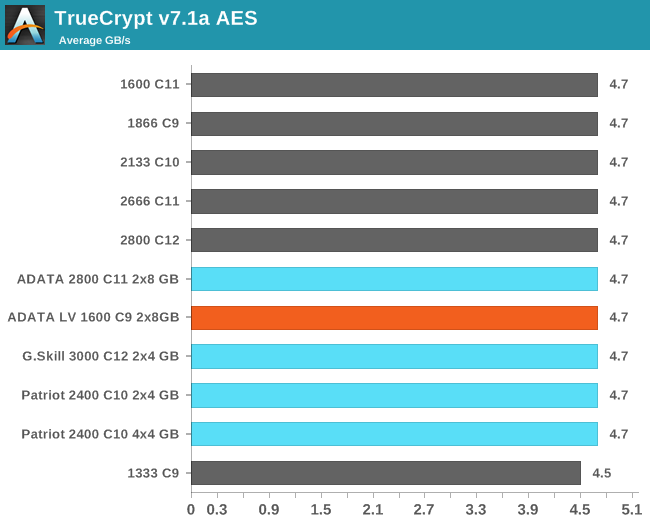










35 Comments
View All Comments
MrSpadge - Sunday, December 8, 2013 - link
> Does low voltage ram avoid this?Nope. It's actually the signal quality and not the power draw which causes them to downclock. I've got a X79 build with 8x8 GB where I simply set XMP at stock frequency (1600 or 1866) and it works without problems. I think it's the same as overclocking memory and controller: Intel doesn't want to validate this, but this doesn't mean it would not work.
BlueReason - Saturday, December 7, 2013 - link
Do you ever look at all the charts full of near-identical sized bars and ask yourself just how worthwhile these RAM reviews are?ShieTar - Tuesday, December 10, 2013 - link
Well, some RAM testing is fundamentally important, in order to understand how much impact there is with current CPUs, RAM, Software, etc.What may be less useful is posting a full article that shows just how little impact there is right now, and then following it up with a steady stream of single RAM tests that only keep on reporting the same conclusion over and over.
cjs150 - Monday, December 9, 2013 - link
I use low profile/low voltage samsung green for my HTPC (which is fanless). Lower voltage = less heat which is obviously beneficial in a fanless computer. The fact that the samsungs were the same price as a good name standard ram meant the decision was very simple.If not going fanless then I would still go for the samsungs where memory height was an issue for a big CPU cooler.
Low voltage is a niche
blackie333 - Tuesday, December 10, 2013 - link
A have a brand new Haswell build with 4670K, Asus Z87-Pro and G.Skill 2400C10 memory. I was quite surprised that in idle mode G.Skill@2400Mhz is consuming much more energy(10Watts) than CPU cores (1-5 watts).Is there any bios setting (except setting DRAM frequency manually too low) to make memory be more effective in idle state(s)? Thank you in advance for advice